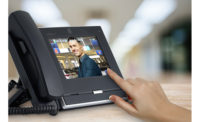In the past, intercoms were fairly simple: there would be a call button and perhaps a mechanism for remotely unlocking a door, and that was it. Eventually, end users and manufacturers began to recognize the value of being able to see who was at the door rather than relying simply on sound, and cameras became part of the equation. While cameras helped improve security, the emphasis was still mainly on the intercom aspect.
Today’s video intercoms have continued to evolve and touch many different aspects of security, making them tremendously valuable in the overall physical security ecosystem.
“If you look at some of the cameras or some of the access control integrations in the past, they were just haphazard,” says Steve Burdet, manager, solutions management, Axis Communications, Chelmsford, Mass. “Some of the new technology has been refining that and showing [that these solutions] can be more professional.”
The merger of video and door intercoms has been driven by the same trend that has been driving other security technologies over the last few years: the move to IP.
“An IP video intercom addresses a couple of areas that hardwired intercoms do not,” says Paul Hefty, technical sales and support engineer II, Aiphone Corp., Redmond, Wash. “It allows an installer to deploy a station wherever there is a network drop. Distance limitations are no longer an issue. Since networks can be wireless, this allows us to install video intercoms in a variety of locations that were not possible in the past.”
One of the evolutions of video intercom systems has been ease of integration and even remote access capabilities.
“In the past we had two types of systems: two-wire and IP,” says Gordon Waughan, product test engineer, Dahua Technology USA, Irvine, Calif. “Two-wire was the norm; but IP has picked up speed because it’s easy to integrate with other systems such as when you want to record video. The ability to access an IP intercom system remotely and locally also makes it appealing.”
Another newer factor that is growing more popular with intercoms is cloud, which Simon St. Jacques, commercial development manager, Sipelia, Genetec, Montreal, says has made video intercoms even easier to install and use. “Mainly, it simplifies the deployment of intercoms, especially when customers have many buildings. So this is maybe the biggest trend at this moment,” he says.
The Resolution Game
As terabyte drivers become more inexpensive for NVRs, resolutions continue to get higher. While there are applications for these high resolutions, door intercoms aren’t one of them.
“For door applications, 4K is overkill,” says Greg Yocom, engineering manager, Viking Electronics, Hudson, Wis. “At that point, you’re filling the NVR fast and eating up too much bandwidth. It’s more standardized on TV resolution than CCTV.”
Choosing the appropriate resolution for most video intercom applications is based on the placement of the intercom and the requirements of the installation, the experts say.
Ranking Video Intercom Integrations
There are a number of potential solutions that can be integrated with video intercoms, but for Steve Burdet of Axis Communications, there are three that stand out from the crowd in terms of importance and relevance.
“I would put them in this order: I would say VoIP is probably the most important because most of these intercoms come with video. I would say VMS is second and then access control, third, because you can still run the door station,” he says.
“I want to be able to see who’s on the other side of a door, but I don’t necessarily need to unlock it from a distance. And you’ll probably need a place for this to be managed from a video and software perspective. But VoIP is still the No. 1 thing; when they press that button, what happens? That’s what is most important.”
“[Resolution] needs to be high enough to a wide enough field of view to capture someone who is 6 feet 4 inches and also someone who is maybe 5 feet tall,” Burdet says. “In that use case, your targets are not very far away and chances are they’re looking at this box, so your demand for higher resolution that you see in traditional cameras ... is greater; but for indoor stations we are seeing some that are going up into 5 megapixel[s]. And who’s interested in those?”
The sweet spot in terms of camera resolution for video intercoms is still 1080p due to bandwidth, imaging and pricing, according to Burdet. “People used to say 1080 was expensive. That was high-res, but now it’s the minimum. So that’s the expectation,” he adds.
There is certainly a trade-off, however, between image quality and bandwidth and storage, which is why the same resolutions that are gaining traction in the overall video surveillance space aren’t trending in video intercoms.
“For intercoms [resolution is] going to stay lower, but you’re still looking at getting most likely HD video, because ultimately you do need to be able to perform visual verification,” says Jean-Pierre Picard, manager, product marketing team, Genetec, Montreal.
Part of the reason for keeping resolution lower has to do with the way video from intercoms is viewed. “Most video intercoms are still viewed on a small screen or on an app running on a smartphone,” Hefty says. “We tend to stay around the 1.2-megapixel range. This allows for great clarity in identifying the visitors without causing bandwidth issues or lagging.
Beyond resolution is the issue of video quality, which Burdet says wasn’t much of a concern in the past. “For intercoms, it was ... the physical form factor in the buttons. And so manufacturers didn’t really concern themselves with what their video looked like,” he says. “Good enough was fine, but that meant dynamic lighting — which these are absolutely going to face — was a challenge. Low lighting can also be a challenge.”
However, this mindset is starting to shift, as technologies advance to make video more usable under a variety of conditions.
Potential Challenges
There are many options available for installing intercoms, so it’s important to find the right system to meet a customer’s needs.
“For example, if it’s a retrofit with existing cabling, then two-wire might be a better option,” says Damon Chou, solutions product manager, Dahua USA. “Another example is if you choose wireless for a residential installation, make sure the Wi-Fi signal from the router or access point is strong enough to reach the intercom system.”
Location and placement are the very first factors that go into designing and installing a video intercom system. Some of the questions integrators should ask include: Can PoE be pulled to the location? Does the location support flush or surface mount and the size of the unit? Is the unit rated for inside, outside or in a hospital environment? Is the intercom rated for vandalism? What is the distance from the PoE switch?
Unlike many surveillance applications, video intercoms are meant to be right in front of a person’s face, so in addition to aesthetics, durability is another factor that dictates how and where they will be installed — and can also lead to new challenges.
Video Intercoms in the Age of Social Distancing
One of the newer phenomena we’ve faced in the world has been the concept of social distancing, brought to light by the global coronavirus pandemic. This has created challenges not only socially, but for technologies that were not designed to accommodate what may be the new norm, says Genetec’s Jean-Pierre Picard.
“Video intercoms are really going to be playing a bigger part in the way facilities are organized and processes are organized. We’re seeing some customers that are using this to limit having to actually go inside a room in a healthcare facility, for example, to limit the chances of transmitting something all while maintaining that frequency of checking,” he says.
One of the main benefits of door intercoms is, simply put, the ability to limit — or even eliminate — human contact at the door.
“Since we are in a pandemic, an immediate need is providing [the customer with] a way to create social distancing upon entry. This can also be applied to healthcare workers,” says Dan Rothrock of Zenitel Americas.
Greg Yocom of Viking Electronics says integrators have to understand this greater demand for security at the door and deliver solutions to their customers. “Everybody is having food, groceries and other things delivered to their door. Demand for that is very high right now. Additional security at the door or the gate is something people want and need,” he says.
“Generally, these get installed in a recessed format, but what does that really mean? At a house, you’re cutting into siding or something not so hard,” Burdet says. “But if you are looking at some commercial buildings ... or schools, you might be talking about brick or concrete or something really difficult to cut a hole and then run your conduit and your cabling and power through as well.” This can pose a problem if a solution needs to be replaced or retrofitted, especially if a hole needs to be re-cut, he adds.
This is why it’s important for the systems integrator to choose a system that can grow with a customer’s business, he says. “The last thing we want to see is a customer trying to add on to a system that is already maxed out. Find a system that can grow as the customer grows.”
Other important installation factors for video intercoms are the direction of the system’s view because of backlighting, as well as the height of the intercom.
“It should be installed by ADA requirements, but remember, those requirements are defined by the location of the button, not the camera” says Dan Rothrock, president, Zenitel Americas, Kansas City, Mo. “And remember, you are focused on communication enhanced by video.”
Particularly with larger, multi-site installations, it’s important to give serious consideration to standardization, too.
“We see it in school districts where a school wants to use small systems in some of their schools and larger systems in others” Hefty says. “Standardizing on one system that meets all the needs helps to ensure that the installations go smoothly. It also helps for future maintenance. If a station needs to be replaced, you only have to worry about removing the one unit.”
Sales Opportunities
For security integrators who include video intercoms as part of their portfolio, video intercom systems can represent a relatively easy way to add value for customers.
“Most people have doors; so there’s an opportunity there to put an intercom on the outside of the doors,” Burdet says. “It can thread the needle to so many places, such as video surveillance, access control, visitor management, audio analytics. If I want to have it looking at a parking lot, maybe there’s a lot of danger out there. So I want to know if a gun has been shot or a car pulls up or any of that stuff. There are so many ways to add value.”
In addition, Picard says, a site visit is the perfect time to identify potential opportunities to address customers’ operational challenges with video intercoms. “When you do that, it’s a great kind of cross sell opportunity and that builds a kind of relationship that doesn’t necessarily come from that initial system purchase. So if the driver is an overhaul of the access control system, for example, sometimes the initial bid will require some manner of video intercoms. But after an integrator has been on site for a while they’ll spot other use cases to manage access to an IT equipment room or things like that. They’ll get an understanding that is not available when you just respond to an RFP.”
And just because a deployment is finished, there’s no reason why video intercoms can’t be part of the conversation moving forward.
“We always recommend looking back through your previous installations where you may have installed an access control system, CCTV, intruder or fire alarm system and see if the end customer could benefit from the addition of a video intercom,” says Samantha Cronin, product specialist, Paxton, Greenville, S.C. “If the Ethernet network is already in place it provides a fantastic opportunity to add additional value to the customer’s site as well as one to grow revenue.”
One approach is to view video intercoms as part of an overall system, rather than standalone offerings. “The best integrators will elevate intercom into the integrated portfolio. And if they are selling managed services, they can begin to sell more cameras and intercom as part of a subscription service,” Rothrock says.




